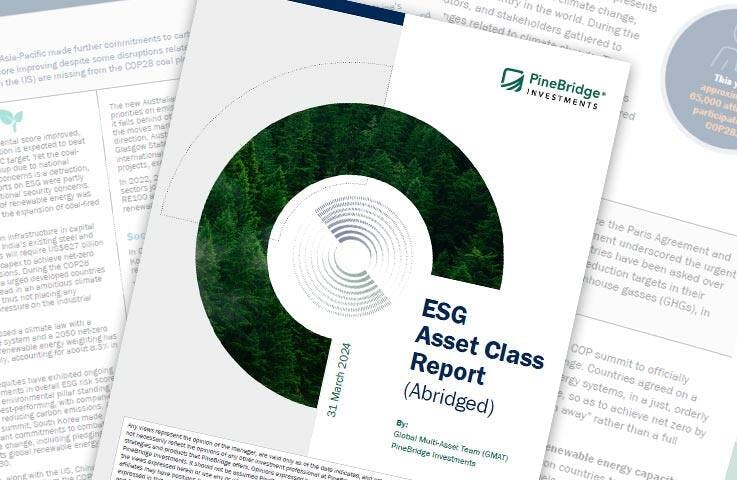Select your geography
Americas
Investment Strategy Insights: Time to Look Ahead to a New Year: 2022

Michael J. Kelly, CFA
Global Head of Multi-Asset

With a tight consensus now formed on the likely shape of 2021, mulling the outlook for 2022 might be more interesting, and more productive. Markets are giant discounting mechanisms. Should the crowd be more right than wrong about vaccination reaching the masses in spring/summer of 2021, unleashing a step-up in mobility in the second half, it’s now baked into prices and time to move on. Unless we veer meaningfully off this presumed path, markets will soon be all about the outlook for 2022.
So, what could the next new year, 2022, look like?
To be sure, Covid-19 will still be influencing the global economy to some degree. While 1 billion people are likely to have been vaccinated by the end of 2021, this would still represent only one-eighth of the global population, though concentrated in countries representing half the global economy. While 2021 will be about lifting the ceiling on growth for most developed economies, 2022 (and beyond) may be the equivalent for most emerging economies.
In this policy-driven recovery, once herd immunity begins to set in for developed economies around midyear 2021, those policymakers will begin to think about withdrawing stimulus. Yet after such a horrific episode, most will likely drag their feet and make sure that we are on safe recovery ground before actually beginning the withdrawal process. This means 2022 will also be about the degree of stimulus withdrawal in developed economies.
Many emerging economies went lighter and later on stimulus, will receive vaccines later, and thus may well not be in a withdrawing state of mind in 2022. China, for one, has its next five-year Party Congress at the end of 2022. No sense rocking the recovery boat before then, which is also a positive for other emerging countries that beat to China’s drum.
With new administrations starting up in the US and Germany in 2021, the coming year will likely be devoted to rebuilding multi-lateral relations and commitments, leading to 2022 as a year to revisit trade issues – another potential plus for more trade-dependent emerging economies.
Meanwhile, with Europe and now China taking steps to reframe regulation of technological platform companies that have been using their status to pre-empt competition, the new US administration will soon also be in search of a new anti-trust theory that does not rely on rising consumer prices as a precondition for taking action. By 2022, the US may be more like-minded with Europe and China, where merely the presence of anti-competitive actions is now enough to presume damage to what “might have been” with respect to smaller firms and the state of competition and innovation.
So with 2021 as preamble, 2022 may well be about monetary and fiscal policy withdrawal, a continued healing process with respect to trade, and new anti-trust concepts upon which technological platforms must operate.
Conviction Score (CS) and Investment Views
The Conviction Scores shown below reflect the investment team’s views on how portfolios should be positioned for the next six to nine months. 1=bullish, 5=bearish, and the change from the prior month is indicated in parentheses.
Global Economy
Markus Schomer, CFA Chief Economist, Global Economic Strategy
CS 2.75 (-0.50)
Stance: It’s finally time to leave the bearish camp and join the more constructive outlooks across most other asset classes.
Outlook: Risks to the outlook are fading for five main reasons. First, China continues to perform well, providing a strong anchor to global growth. Second, the arrival of several vaccines will diminish the impact of any additional waves. Third, many developed market (DM) central banks have upped their quantitative easing programs or at least extended their buyer-of-last-resort commitments. Fourth, Congress finally agreed on another fiscal package. Finally, a Brexit deal has come to fruition after the UK accepted a customs border in the Irish Sea. All that means the global recovery faces less downward risk and is likely to close the recession gap.
Risks: January runoff elections for the US Senate in Georgia could inject more political risk if Republicans retain a majority in the Senate, raising the specter of renewed fiscal austerity. More financial market volatility could emanate from the falling US dollar or corrections in overvalued global asset markets, which may test central bank resolve next year.
Asia Economy
Paul Hsiao Economist, Global Economic Strategy
CS 2.50 (-0.25)
Stance: Our upgraded CS reflects growing confidence in Asia’s economy over the next six to nine months.
Outlook: The centenary of the founding of the Chinese Communist Party suggests that policy will remain accommodative through 2021. Ex-India, Asia has handled Covid-19 relatively well thus far, which is a tailwind to growth in 2021. Secular growth opportunities are likely to continue, especially among companies focused on R&D and sustainability.
Risks: Coronavirus flare-ups and prolonged lockdowns remain primary risks, especially in emerging-market (EM) Asia. A step up in trade tensions that could curb export growth and a policy error in the form of tightening too fast also are risks.
Rates
Gunter Seeger Portfolio Manager, Developed Markets Investment Grade
CS 4.00 (+1.0)
The Fed giveth and the Fed taketh, but is the former enough? Its swap lines with other central banks and its repo facility continue until September 2021. It is committed to buying $80 billion of Treasury bonds and $40 billion of mortgage-backed securities until its 2% inflation goal is met, which could take years. Even the Fed itself sees no change in policy until 2023, at the earliest. On the take side, it will wait for the incoming administration until buying more, which means the projected budget deficit of $2.1 trillion for 2021 will require $1.1 trillion in private purchases.
Credit
Steven Oh, CFA Global Head of Credit and Fixed Income
CS 2.75 (unchanged)
When valuations fully reflect the fundamental outlook, as they do now, we usually become more defensive. But these are unusual times. December debt supply was much greater than anticipated due to strong demand and low absolute yields, but supply should slow and further buoy technical support, leading to further credit spread compression into 2021. As a result, we have maintained our positive tilt toward risk.
Currency (USD Perspective)
Joey Cuthbertson, CFA Associate Trader, Fixed Income
CS 3.00 (unchanged)
The factors creating US dollar weakness remain intact for the short term, but economic recovery in the second half of 2021 could change the currency’s direction. Among G10 currencies, the Australian dollar and the Norwegian krone could be the main beneficiaries of a slightly weaker US dollar; the British pound continues to trade on Brexit headlines. China’s recovery leads to optimism that EM growth will outpace G3 growth in 2021 by a significant margin, strengthening the case for a recovery in select EM currencies. We believe the Mexican peso, the Colombian peso, and the Russian ruble are best positioned to benefit from the improved sentiment.
Emerging Markets Fixed Income
Steve Cook Managing Director – Co-Head of Emerging Markets, Fixed Income
USD EM (Sovereign and Corp.)
CS 3.00 (+0.50)
Local Markets (Sovereign)
CS 2.75 (unchanged)
The November-December “Santa rally” took much of the juice out of valuations for EM dollar securities for the short term, but they still provide attractive opportunities versus comparable DM vehicles over a 12-month investment horizon. On a longer time scale, we view any shakeup in valuations as an opportunity to buy. While the fundamental outlook for EM remains positive and the technical/strategic allocations to the market continue, the recent significant spread tightening has led us to adjust our US dollar CS back to neutral 3.0. The strong EM outlook and the current US dollar weakness cause us to maintain our CS for local markets in slightly bullish territory at 2.75.
Multi-Asset
Jose Aragon Senior Vice President, Portfolio Manager, Global Multi-Asset
CS 2.30 (-0.20)
With vaccine-powered expectations of robust economic revival in the US and other developed markets in mid-2021 and with our Capital Market Line (CML) retaining its upward slope, we’ve revised our CS to a more constructive 2.30. We view the likely market jitters this winter as an opportunity to add risk. We also see China’s ongoing policy support continuing to focus on infrastructure spending well into 2022, which bodes well for commodity-centric beneficiaries, particularly in Latin America, along with industrials and other cyclical sectors. Yet as reopenings take hold in the spring, we expect the hard-hit travel and services sectors to lead the next phase of recovery.
Global Equity
Chris Pettine, CFA Senior Vice President, Senior Research Analyst, Global Focus Equities
CS 2.75 (unchanged)
We maintain our view that markets will continue to look past the painful present of Covid-19 and see the vaccine rollouts as bringing some version of normalization in the second half of 2021. While absolute valuations of the market currently are at historical highs, earnings revisions are trending higher, CEO confidence is strong, and the wide valuation gap between value and growth should present investment opportunities in a business cycle expansion. As a result, we maintain our CS at 2.75.
Global Emerging Markets Equity
Taras Shumelda Portfolio Manager, Global Equities
CS 2.75 (unchanged)
On the back of strengthening economies and markets, which saw global EM equities rise 14.5% in 2020 through late December, we are keeping our score at 2.75. In China, exports have risen 21.1% year-over-year, to a seven-year high. In India, auto sales and consumer discretionary spending have been strong. In most of Latin America, contagion is falling. That, coupled with vaccine developments and the outcome of US elections, creates a more favorable environment, benefiting local currencies. EMEA has been relatively stable, with the recent EU stimulus agreement providing additional underpinning.
Quantitative Research
Peter Fwu Quantitative Strategist, Quantitative Fixed Income Shared Services
Our US Market Cycle Indicator (MCI) has improved as spreads on the BofA/ML US Corporate BBB index tightened 28 basis points in November. Investment grade and high yield spreads continued normalizing on the long ends. We favor DM over EM credit and like cyclical sectors including basic industry, consumer goods, and capital goods versus the natural gas and electric sectors. Our rates model maintained its forecasts for rising global yields and steeper curves but more muted magnitudes. The rates view expressed in our G10 model portfolio was slightly overweight global duration: underweight the euro area and the US, and overweight Australia, Japan, and the UK. On curve positioning, our model portfolio overweights five- and 10-year durations and underweights other key rate durations.
Disclosure
Investing involves risk, including possible loss of principal. The information presented herein is for illustrative purposes only and should not be considered reflective of any particular security, strategy, or investment product. It represents a general assessment of the markets at a specific time and is not a guarantee of future performance results or market movement. This material does not constitute investment, financial, legal, tax, or other advice; investment research or a product of any research department; an offer to sell, or the solicitation of an offer to purchase any security or interest in a fund; or a recommendation for any investment product or strategy. PineBridge Investments is not soliciting or recommending any action based on information in this document. Any opinions, projections, or forward-looking statements expressed herein are solely those of the author, may differ from the views or opinions expressed by other areas of PineBridge Investments, and are only for general informational purposes as of the date indicated. Views may be based on third-party data that has not been independently verified. PineBridge Investments does not approve of or endorse any republication of this material. You are solely responsible for deciding whether any investment product or strategy is appropriate for you based upon your investment goals, financial situation and tolerance for risk.

Multi-Asset
Explore PineBridge’s world-class multi-asset solutions
Recent Insights


